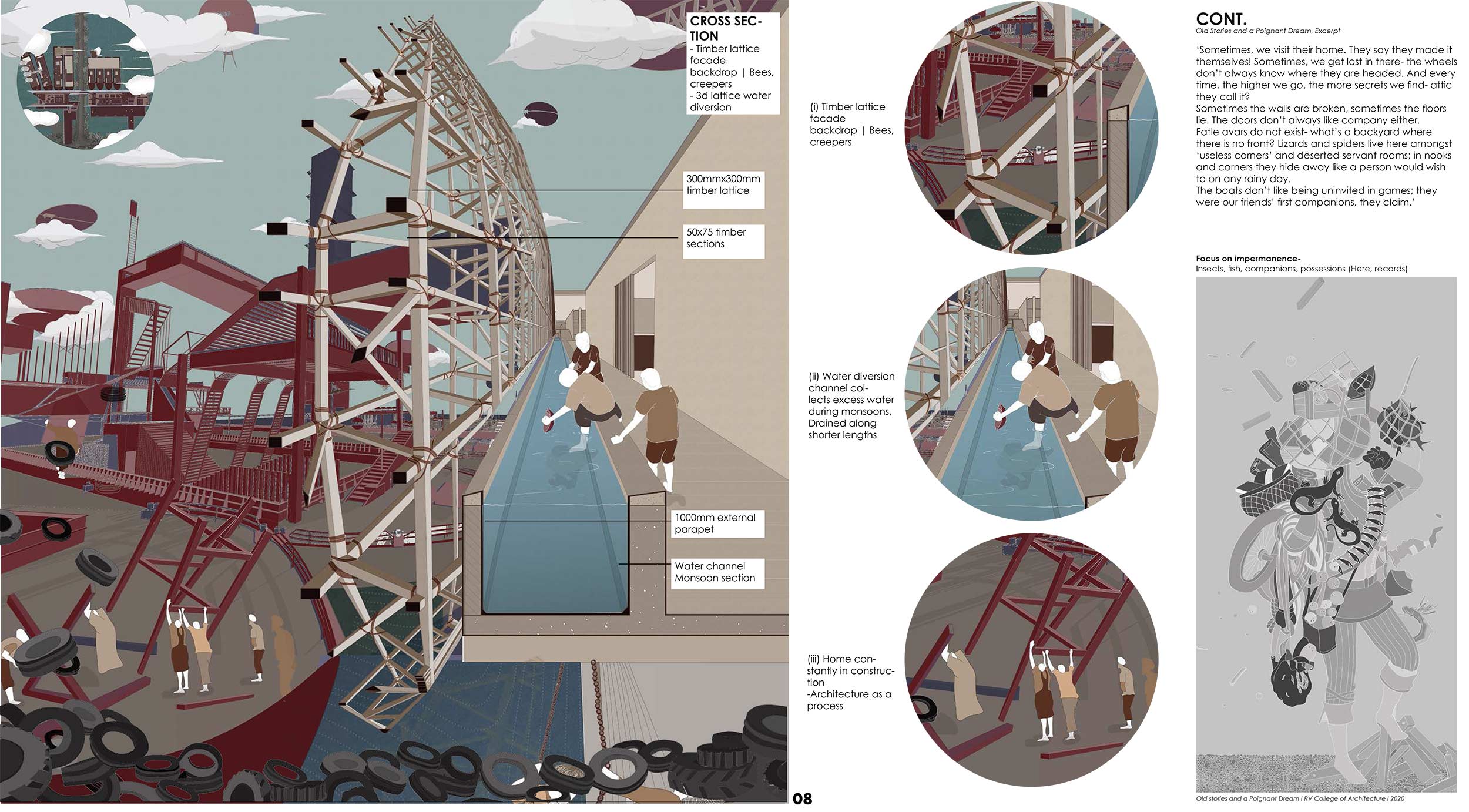top architecture design thesis 2020


RV COLLEGE OF ARCHITECTURE
BENGALURU, INDIA

Design thesis authored by
Gayatri Ganesh
share
THESIS SPECIFICATIONS
Thesis Title : Old stories and a Poignant Dream
Location : Dock area- Chicalim, Goa, India
Project type: Night Shelter | Gallery
Year of completion : 2020
Name of Thesis mentor: Anup Naik, Mehul Patel, Nagaraj Vastarey, U Seema Maiya
Proposition
Related words: Magical Realism, children, memories, dreams, storytelling, dwelling, home, water, place
If a child’s perception of reality is often colored by elements of fantasy, do principles of architecture remain steadfast at this threshold of transience?
This thesis sits in a realm, where spaces wound with memories allow for timelines to collide, and follows a parallel narrative between two worlds- the real, and its counterpart- the imaginary/ the dream. Here, the intervention acts as a backdrop to a short story ‘Old Stories and a Poignant Dream- A tale’
How children perceive their reality accommodating natural slips between their dreamscapes and an adult’s perspective of their world, largely influences the architecture that aims to house them.
Here, in memory of Poskem from 18th c. Goan Inquisition- orphans from poor households later adopted into mistreatment, escape their 17th century adoptive homes, away from assault and a tradition rooted in their part Portugal heritage. They come across a familiar landscape-a forgotten industrial artifact, which offers them refuge. Working around it and making it their own, the place is imagined and manipulated as an escape to their past, however very much influenced by it.
Often, they meet children of the present who have similar stories to share, take them through struggles of their own in the form of stories, thereby providing a safe space that allows them to let go and dream.
Premise
‘The Day does not know the Night exists, and the Night knows nothing of the Day.
Why does their home touch the sky?
How else does one stitch it?
The world here is new- leaves speak to the river, and boats don’t move. It’s been 350 years since our friends ran away from their homes.’
Old stories and a Poignant Dream-A tale
Given that Realism is a tool popular in art, literature, that directly depicts reality- observation, unbiased portrayals of everyday life, disregarding artistic freedom, and rejecting imagination; Magical Realism accommodates for fantastical elements derived from/ in essence based on collective narratives. Aspects of architecture taken for granted in our reality include time space relationships, trust in planes, humanized scales, repetition- memory and references to shared history. To imagine a setting, where these aspects of reality are intercepted by familiar elements that disrupt it/ one’s perception of space, in order to let a mind wander seamlessly is the intention Old Stories and a Poignant Dream presents.
Approach
Derived from footprints of traditional Goan homes, memory of architectural elements- arches, courts, columns, vertical and horizontal surfaces, ‘useless corners’ (In reference to Georges Perec, Species of Spaces and Other Pieces) where spiders, lizards are as comfortable in a home as its people are, and basements, attics hide secrets (Poetics of Space, Gaston Bachelard) contributing to a ‘broken’ home where elements are deceptive and constantly in construction- owing to the influence of broken
memories.
Can we rely on fish to carry stories across a river?
Are pinwheels equivalent to prayer flags?
If information grows on a daily basis, why don’t libraries?
“Sometimes, we visit their home. They say they made it themselves! Sometimes, we get lost in there- the wheels don’t always know where they are headed. And every time, the higher we go, the more secrets we find- attic they call it? Sometimes the walls are broken, sometimes the floors lie. The doors don’t always like company either, unlike Vasro, Balcao (verandahs) and Angan Parsu (courtyard gardens) always ready to say “Hello!” Fatle avars do not exist- what’s a backyard where there is no front? Lizards and spiders live here amongst „useless corners‟ and deserted Vavradi kud (servant rooms); in nooks and corners they hide away like a person would wish to on any rainy day. The boats don’t like being uninvited in games; they were our friends’ first companions, they claim.”
“To put down roots, to rediscover or fashion your roots, to carve the place that will be yours out of
space, and build, plant, appropriate, millimeter by millimeter, your home‟: to belong completely in your
village, knowing you‟re a true inhabitant”
-Georges Perec, Species of Spaces and Other Pieces
This landscape accessed through a delicate timber unit that acts as an interface between Goa Mainland and the Zuari, where children can learn, play, and grow- A Night Shelter; a Hall of Memories, contribute to the Public’s understanding of their History with respect to Poskem, and experience the river differently- A bank to run around in through Summers, wet feet in monsoons. Barges contributing to this landscape with their varying levels, ladders, ropes, tyres, and spare parts provide a child with opportunities for play. Water channels that run across the unit longitudinally, carrying excess water during monsoons, disposed of along either sides, mimicking the river- a chance for another paperboat.
“Every Day is the same. Some of us leave, and some of us stay to play games. That’s when the Big people come in, they like to join us sometimes. Mostly, they say things none of us have heard before and leave with the Sun. At Night, our friends come to visit when we are all here. They let us play with them. Once in a while, they share bedtime stories too-”
“Memories are motionless, and the more securely they are fixed to a place, the sounder they are.”
-Gaston Bachelard
Conclusion
Testing boundaries of architecture- placemaking used as a tool in storytelling- a speculative manifestation of guilt/stories of war and its traditions that are lost with time.
A night shelter that lets a child dream and a landscape based on elements of architecture that ‘break’ when memories associated with ‘Home’ turn unpleasant- place of play/comfort to children, and nostalgia to adults; Magical Realism here- with abandoned objects of recent political legacy, allow for a natural slip between daydreams and an adult’s understanding of reality.
‘What survives the night is that which knows to imagine.’
the end
Copyright information: ©️ Student author 2021. Prior written authorization required for use.
Request permissions: If you wish to use any part of the documentation forming part of the undergraduate thesis submitted to DSGN arcHive, please seek prior permission from the concerned student author through the respective college/university.
Exclusion of liability: DSGN arcHive and its owner do not undertake any obligation to verify the ownership of any content submitted for publication/broadcast on this website and shall not be liable for any infringement of copyright by, or unauthorized use of, such content.
HOMEPAGE
Copyright © 2025 DSGN arcHive
